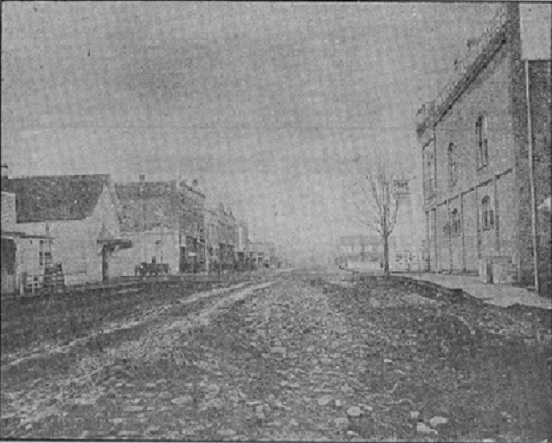Business and Commerce
Early Day Scene Shows Boulder Streets

Polk County Itemizer-Observer, Thursday, June 20, 1929 The picture to the right, which numerous old timers have established as being taken in the early 1890’s, shows Dallas at a period when it was probably making its most rapid changes from a pioneer village to an important city. Several of the first permanent buildings had recently been completed. The streets, which previously had been bottomless mud in the winter and dust in the summer, had been reinforced with boulders and a top covering of finer rock, as the foreground indicates.
The photograph was taken from Main Street looking north from a point probably in front of the present J. C. Penny Co. store. The corner now occupied by Mac-Marr Store was then a new brick building, which was the home of Fenton & Toner’s general store.
A board fence surrounded the courthouse square (barely visible, on the right side of this photo) but was torn down at the time the new courthouse was built in 1899, and the fire bell tower was located in the southwest corner of the square.
The large building on the right background was known as the Jap restaurant building and was located where the new home of the Mountain States Power Co. is now being built.
On the left foreground is the law office of J. L. Collins, which was later moved near the Collins’ residence on Court Street, where it still remains. The church building, occupying the present Dallas National Bank corner, was the old Methodist church, and at the time of the picture, it housed a hardware store. At one time it was used as a gymnasium.
The office of Dr. M. Hayter, dentist, was located to the upstairs of the Wilson building and the shingle may be noticed below the window.
The original photograph, from which this cut was made, is in the possession of August Risser, and shows the general details more clearly.
THE MILL RACE
1858, John Waymire purchased the right of ways through Dallas for a mill race to get water to run his grist mill and foundry, which later became the Dallas Machine and Locomotive Works. (Later Gerlinger)
John Waymire began to dig the Mill race starting West of town near the intersection of Hunter and Washington streets, where a dam was built (ruminants were visible while I was growing up), so the water flowed by gravity, past the park, possibly near the west end of Washington to turning north in the Canterbury division, along the west side of Levens to Oak, then followed Oak to Main and turned south and flowed on the west side of Main to mid-block and then crossed Main Street and ran east under Guy’s Hardware. It remained east bound mid-block to Shelton. It crossed Shelton and about third way through the block turned northeast to Mill Street and then more east along the county road where it found its way to the area known today as the city shops.
The mill race split slightly here and on the southern branch was the Dallas Foundry, with a machine shop, pattern shop and storage that was owned by owned Ed Biddel in 1882. The Ripley and Coad Planing Mill and Sash and Door factory were next door to Waymire’s flour and grain mills. On the north side of the mill race was the City Electric and Light Works where T.A. Riggs started the first electric plant. The city’s first generating plant, a 20-arc capacity dynamo, began to operate in the fall of 1889, to light up the city’s first 5 lamps.
The Mill Race was a mixture of open ditches and boxed open and covered flumes that ran the length of Main Street, where cisterns were located on each block to get water to fight fires. The dam controlled the amount of water running through the race at any time.
If you were to look at an older topographical map, you could almost see the path of the mill race.

Mill Race Dam